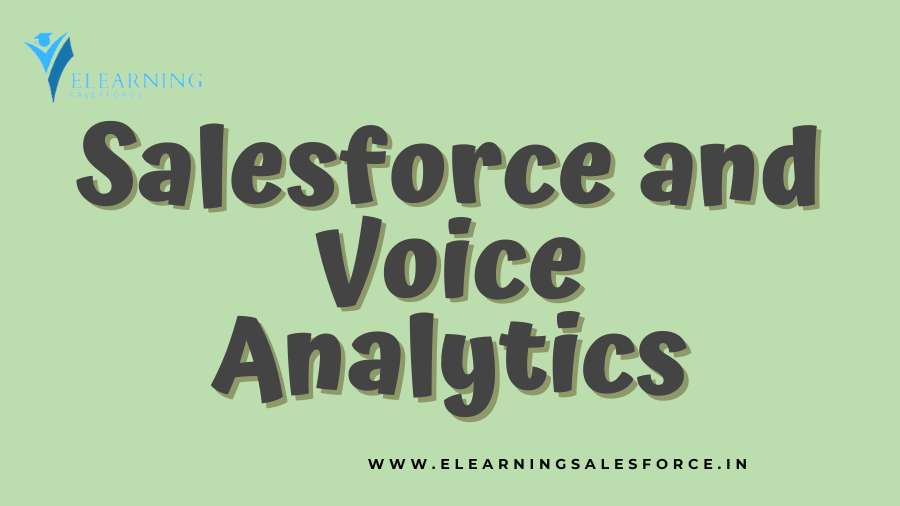Salesforce, a leading customer relationship management (CRM) platform, is undergoing a transformative synergy with the advent of voice analytics. In this article, we explore the dynamic integration, benefits, challenges, and real-life success stories of combining Salesforce with voice analytics for a data-driven approach to sales.
Introduction
Definition of Salesforce
Salesforce is a cloud-based CRM platform known for its versatility in managing customer relationships, sales processes, and marketing initiatives. Its adaptability makes it an ideal foundation for exploring innovative technologies like voice analytics.
Emergence of Voice Analytics in Business
Voice analytics involves the analysis of voice data to derive insights and patterns. As businesses increasingly recognize the value of voice, integrating it with Salesforce opens new possibilities for understanding customer interactions and improving sales strategies.
The Synergy Between Salesforce and Voice Analytics
Integration for Enhanced Customer Insights
By integrating voice analytics into Salesforce, businesses gain deeper insights into customer interactions. This enables a more comprehensive understanding of customer needs, preferences, and sentiment, enhancing overall customer relationship management.
Streamlining Sales Processes with Voice-Driven Data
Voice-driven data adds a layer of efficiency to sales processes. Sales representatives can access relevant information through voice commands, reducing the time spent on manual data entry and allowing them to focus on building meaningful connections with clients.
Benefits of Adopting Salesforce and Voice Analytics
Improved Customer Experience
The integration of Salesforce and voice analytics contributes to a more personalized customer experience. Sales teams can tailor their approach based on voice-driven insights, creating a more engaging and customer-centric interaction.
Data-Driven Decision-Making
Voice analytics provides valuable data that, when integrated with Salesforce, empowers businesses to make informed decisions. This data-driven approach enhances the accuracy and effectiveness of sales strategies, leading to better outcomes.
Challenges and Solutions in Implementing Voice Analytics with Salesforce
Ensuring Data Security
The integration of voice data raises concerns about data security. Businesses must implement robust security measures to safeguard sensitive information, ensuring compliance with data protection regulations.
Overcoming Integration Hurdles
Integrating voice analytics seamlessly with Salesforce may pose technical challenges. Addressing these hurdles requires a strategic approach, including collaboration between IT teams and solution providers.
Real-Life Success Stories
Companies Excelling with Salesforce and Voice Analytics
Real-life success stories highlight how businesses have leveraged the combined power of Salesforce and voice analytics to achieve significant improvements in customer satisfaction, sales performance, and operational efficiency.
Quantifiable Business Improvements
Measurable outcomes, such as increased conversion rates, shorter sales cycles, and higher customer retention, demonstrate the tangible business improvements achieved through the integration of Salesforce and voice analytic.
Future Trends in Voice Analytics and Salesforce
Advanced AI Integration
The future holds exciting possibilities with advanced AI integration. Salesforce and voice analytic are poised to leverage AI for even more sophisticated insights and predictive analytic.
Predictive Analytics for Sales Optimization
The integration of predictive analytic into Salesforce through voice-driven data is a future trend that promises to revolutionize sales optimization, allowing businesses to anticipate customer needs and market trends.
How to Implement Salesforce and Voice Analytics
Step-by-Step Guide for Seamless Integration
A step-by-step guide assists businesses in the seamless integration of Salesforce and voice analytic. This includes selecting compatible tools, configuring settings, and ensuring data flows smoothly between the two systems.
Best Practices for Optimization
Best practices, such as continuous monitoring, regular updates, and employee training, contribute to the optimal functioning and ongoing success of Salesforce and voice analytic integration.
User Feedback and Reviews
Positive Experiences with Salesforce and Voice Analytics
User testimonials underscore the positive impact of Salesforce and voice analytic on day-to-day operations. Users highlight improved workflow efficiency, enhanced decision-making, and a more intuitive user experience.
Areas of Improvement
Constructive feedback from users offers insights into areas where Salesforce and voice analytic can be further optimized. This user-centric approach guides developers in refining and enhancing the integration.
Comparison with Traditional Sales Analytics
Salesforce and Voice Analytics vs. Conventional Methods
Comparing the integration of Salesforce and voice analytic with traditional sales analytic methods highlights the unique advantages, including faster data input, more accurate insights, and enhanced user experience.
Unique Features and Advantages
The unique features of Salesforce and voice analytic, such as natural language processing and sentiment analysis, distinguish them as superior tools for gaining actionable insights from customer interactions.
Tips for Maximizing Salesforce and Voice Analytics
Leveraging Conversational Insights
Maximizing the benefits of voice analytics involves leveraging conversational insights. Sales teams can extract valuable information from voice data to tailor their approach and enhance customer engagement.
Continuous Training and Optimization
Ongoing training ensures that sales teams are well-versed in utilizing the full potential of Salesforce and voice analytic. Continuous optimization of settings and processes contributes to sustained success.
Addressing Concerns about Cost
Initial Investment vs. Long-Term Gains
While the initial investment in Salesforce and voice analytic integration may be significant, the long-term gains, including improved sales performance and customer satisfaction, often justify the cost.
Scalability and Cost-Efficiency
Salesforce’s scalability ensures that businesses can grow without outgrowing their CRM system. The cost-efficiency of the integration becomes evident as its positive impact on business operations becomes more pronounced.
The Impact of Salesforce and Voice Analytics on Sales Teams
Empowering Sales Representatives
Salesforce and voice analytic empower sales representatives by providing them with tools that enhance efficiency and effectiveness. This empowerment translates to more meaningful customer interactions and increased sales.
Adapting to Remote Work Dynamics
The integration of Salesforce and voice analytic is particularly valuable in the context of remote work dynamics. Sales teams can access and manage data efficiently, regardless of their physical location.
Case Study: Transformative Changes with Salesforce and Voice Analytics
Implementation Journey
A detailed case study explores the transformative changes a business experienced during the implementation of Salesforce and voice analytic. It outlines challenges faced, strategies employed, and milestones achieved.
Measurable Outcomes
Examining the measurable outcomes of the case study provides tangible evidence of the positive impact Salesforce and voice analytic can have on sales team performance and overall business success.
Ethical Considerations in Voice Analytics
Privacy Concerns
As voice data is collected and analyzed, privacy concerns arise. Businesses must prioritize ethical data usage, ensuring that customer privacy is respected and protected.
Ensuring Ethical Data Usage
Implementing guidelines for ethical data usage is crucial. This includes obtaining informed consent, anonymizing data where possible, and being transparent about how voice data is utilized.
Conclusion
In conclusion, the integration of Salesforce and voice analytics marks a significant milestone in the evolution of CRM and sales analytics. The combined power of these technologies offers businesses a competitive edge, enabling them to better understand their customers, make informed decisions, and drive success in an ever-changing market.




